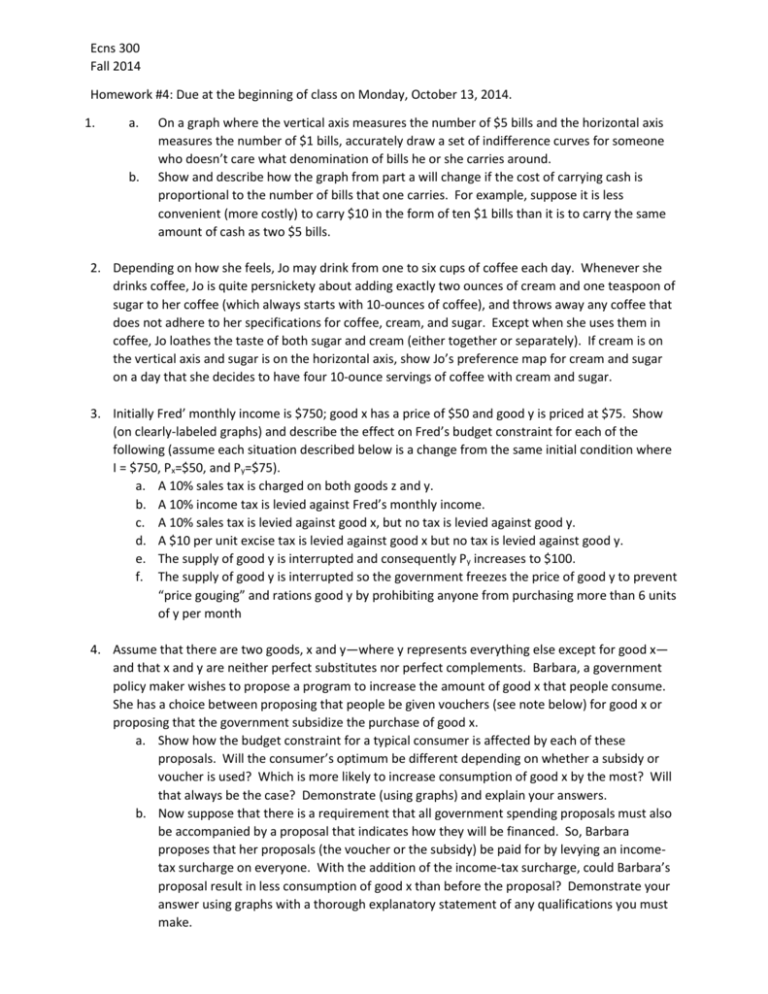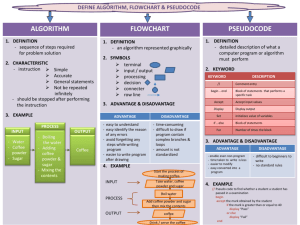Ecns 300 Fall 2014 Homework #4: Due at the beginning of class on
advertisement

Ecns 300 Fall 2014 Homework #4: Due at the beginning of class on Monday, October 13, 2014. 1. a. b. On a graph where the vertical axis measures the number of $5 bills and the horizontal axis measures the number of $1 bills, accurately draw a set of indifference curves for someone who doesn’t care what denomination of bills he or she carries around. Show and describe how the graph from part a will change if the cost of carrying cash is proportional to the number of bills that one carries. For example, suppose it is less convenient (more costly) to carry $10 in the form of ten $1 bills than it is to carry the same amount of cash as two $5 bills. 2. Depending on how she feels, Jo may drink from one to six cups of coffee each day. Whenever she drinks coffee, Jo is quite persnickety about adding exactly two ounces of cream and one teaspoon of sugar to her coffee (which always starts with 10-ounces of coffee), and throws away any coffee that does not adhere to her specifications for coffee, cream, and sugar. Except when she uses them in coffee, Jo loathes the taste of both sugar and cream (either together or separately). If cream is on the vertical axis and sugar is on the horizontal axis, show Jo’s preference map for cream and sugar on a day that she decides to have four 10-ounce servings of coffee with cream and sugar. 3. Initially Fred’ monthly income is $750; good x has a price of $50 and good y is priced at $75. Show (on clearly-labeled graphs) and describe the effect on Fred’s budget constraint for each of the following (assume each situation described below is a change from the same initial condition where I = $750, Px=$50, and Py=$75). a. A 10% sales tax is charged on both goods z and y. b. A 10% income tax is levied against Fred’s monthly income. c. A 10% sales tax is levied against good x, but no tax is levied against good y. d. A $10 per unit excise tax is levied against good x but no tax is levied against good y. e. The supply of good y is interrupted and consequently Py increases to $100. f. The supply of good y is interrupted so the government freezes the price of good y to prevent “price gouging” and rations good y by prohibiting anyone from purchasing more than 6 units of y per month 4. Assume that there are two goods, x and y—where y represents everything else except for good x— and that x and y are neither perfect substitutes nor perfect complements. Barbara, a government policy maker wishes to propose a program to increase the amount of good x that people consume. She has a choice between proposing that people be given vouchers (see note below) for good x or proposing that the government subsidize the purchase of good x. a. Show how the budget constraint for a typical consumer is affected by each of these proposals. Will the consumer’s optimum be different depending on whether a subsidy or voucher is used? Which is more likely to increase consumption of good x by the most? Will that always be the case? Demonstrate (using graphs) and explain your answers. b. Now suppose that there is a requirement that all government spending proposals must also be accompanied by a proposal that indicates how they will be financed. So, Barbara proposes that her proposals (the voucher or the subsidy) be paid for by levying an incometax surcharge on everyone. With the addition of the income-tax surcharge, could Barbara’s proposal result in less consumption of good x than before the proposal? Demonstrate your answer using graphs with a thorough explanatory statement of any qualifications you must make. Note: a voucher is a token or piece of paper that can exchanged for a set amount of a specified good. For example, food stamps are vouchers. Another example that is currently being examined are “educational vouchers.” In states where they are employed, qualifying parents are given a voucher for $X to be spent on sending their child(ren) to a school of their choice, regardless of whether it is a “public” or “private” school and regardless of whether the school is “local” or “distant” from the home. If a parent wishes to spend more than $X on their child’s education, they are free to do so.


![저기요[jeo-gi-yo] - WordPress.com](http://s2.studylib.net/store/data/005572742_1-676dcc06fe6d6aaa8f3ba5da35df9fe7-300x300.png)




